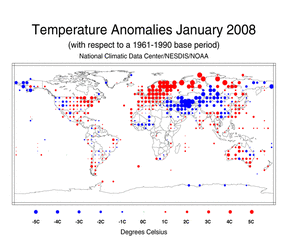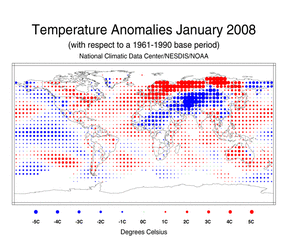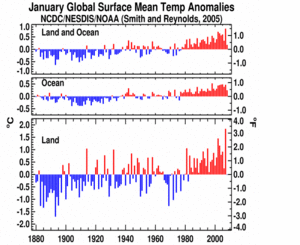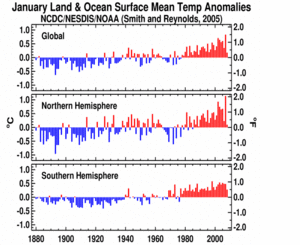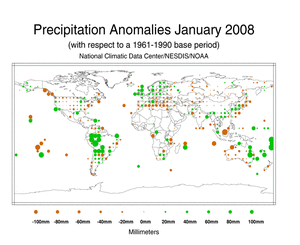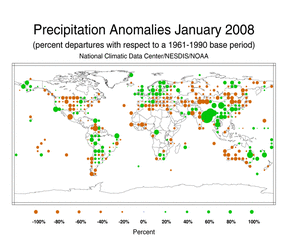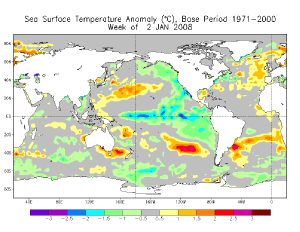Global Highlights:
- Based on preliminary data, the globally averaged combined land and sea surface temperature was the thirty-first warmest on record for January 2008.
- January 2008 temperatures were above average in Europe, northern Asia, the eastern and central parts of the contiguous U.S., and most of Australia. Cooler-than-average conditions occurred in the Middle East, central Asia, southeast China, western U.S., and western Alaska.
- Precipitation during January 2008 was above average in England, northern Europe, eastern Australia, southeastern China, and parts of South America. Drier-than-average conditions were observed in Japan, southern Europe, the western coast of Canada, the eastern and central U.S., and most of western Australia.
- Cold phase (La Niña) ENSO conditions persisted during January.
Contents of this Section:
The data presented in this report are preliminary. Ranks and anomalies may change as more complete data are received and processed. The most current data may be accessed via the Global Surface Temperature Anomalies page.
Introduction
Temperature anomalies for January 2008 are shown on the dot maps below. The dot map, below left, provides a spatial representation of anomalies calculated from the Global Historical Climatology Network (GHCN) data set of land surface stations using a 1961-1990 base period. The dot map, below right, is a product of a merged land surface and sea surface temperature anomaly analysis developed by Smith and Reynolds (2005). Temperature anomalies with respect to the 1961-1990 mean for land and ocean are analyzed separately and then merged to form the global analysis. Additional information on this product is available.
During January 2008, there were above average temperatures across Europe, northern Asia, the eastern parts of the contiguous U.S, and most of Australia. According to the Bureau of Meteorology (BoM), Australia had its warmest January on record. Temperatures were 3-4°C (5-7°F) above average across large areas in Western and Central Australia. The January 2008 average temperature for the nation was 1.23°C (2.21°F) above the 1961-1990 mean, which exceeded the previous anomaly record of +1.16°C (+2.09°F) set in January 1999. Elsewhere, cooler-than-average conditions occurred in the Middle East, central Asia, southeast China, the western U.S., and western Alaska. The anomalously cool conditions over central Asia and southeast China were associated with the largest January snow cover extent on record for the Eurasian continent and for the Northern Hemisphere.
Sea surface temperatures (SSTs) were warmer than average in the Atlantic, Indian, and the northwestern Pacific oceans. Cooler-than-average conditions were present in the southern oceans and in the Niño regions. Temperatures in parts of these Niño regions were more than 1°C (1.8°F) below average, and the average temperature in the Niño 3.4 region decreased markedly in January to approximately -1.77°C (-3.19°F). Please see the latest ENSO discussion for additional information.
The mean position of the upper level ridges of high pressure and troughs of low pressure (depicted by positive and negative 500-millibar height anomalies on the January map) are generally reflected by areas of positive and negative temperature anomalies at the surface, respectively. For other Global products see the Climate Monitoring Global Products page.
Images of sea surface temperature conditions are available for all weeks during 2008 at the weekly SST page.
Temperature Rankings and Graphics
Effective with the February 2006 report, NCDC transitioned from the use of the Operational Global Surface Temperature Index (Quayle et al. 1999) to the blended land and ocean dataset developed by Smith and Reynolds (2005). The differences between the two methods are discussed in Smith et al. (2005).
January 2008 ranked as the thirty-first warmest January since records began in 1880 for combined global land and ocean surface temperatures. Temperatures were colder than average across large parts of central Asia and southeastern China. The January global land surface average was below the 20th century mean for the first time since 1982. La Niña, the cold phase of the El Niño-Southern Oscillation, persisted in the equatorial Pacific, damping ocean surface temperatures. The global average ocean surface temperature (SST) in January was the seventeenth warmest on record.
| January | Anomaly | Rank | Warmest (or Next Warmest) Year on Record |
|---|---|---|---|
GlobalLandOcean Land and Ocean |
-0.01°C (-0.02°F) +0.25°C (+0.45°F) +0.18°C (+0.32°F) |
63rd warmest 17th warmest 31st warmest |
2007 (+1.84°C/3.31°F) 1998 (+0.52°C/0.94°F) 2007 (+0.83°C/1.49°F) |
Northern HemisphereLandOcean Land and Ocean |
-0.17°C (-0.31°F) +0.26°C (+0.47°F) +0.10°C (+0.18°F) |
70th warmest (60th coolest) 13th warmest 48th warmest |
2007 (+2.23°C/4.01°F) 1998 (+0.51°C/0.92°F) 2007 (+1.14°C/2.05°F) |
Southern HemisphereLandOcean Land and Ocean |
+0.48°C (+0.86°F) +0.24°C (+0.43°F) +0.28°C (+0.50°F) |
12th warmest 29th warmest 21st warmest |
2006 (+0.77°C/1.39°F) 1998 (+0.55°C/0.99°F) 1998 (+0.58°C/1.04°F) |
The most current data may be accessed via the Global Surface Temperature Anomalies page.
Precipitation
The maps below represent anomaly values based on the GHCN data set of land surface stations using a base period of 1961-1990. During January 2008, above average precipitation fell over areas that include England, northern Europe, eastern Australia, southeastern China, and parts of South America. Drier-than-average conditions were observed in Japan, southern Europe, the western coast of Canada, the eastern and central U.S., and most of western Australia. Additional details on flooding and drought can also be found on the January Global Hazards page.
ENSO SST Analysis
Sea Surface Temperature (SST) anomalies continued to decrease across the central and western equatorial Pacific during January with cooler anomalies extending further west of the International Date Line. These conditions are indicative of a strong ENSO cold event (shown in the adjacent animation of weekly SST anomalies). A comprehensive summary of January 2008 ENSO conditions can be found on the ENSO monitoring page. For the latest advisory on ENSO conditions go to NOAA's Climate Prediction Center (CPC) and the CPC ENSO Diagnostic Discussion.
Images of sea surface temperature conditions are available for all weeks since 2003 at the weekly SST page.
References
Peterson, T.C. and R.S. Vose, 1997: An Overview of the Global Historical Climatology Network Database. Bull. Amer. Meteorol. Soc., 78, 2837-2849.
Quayle, R.G., T.C. Peterson, A.N. Basist, and C. S. Godfrey, 1999: An operational near-real-time global temperature index. Geophys. Res. Lett., 26, 333-335.
Smith, T.M., and R.W. Reynolds (2005), A global merged land air and sea surface temperature reconstruction based on historical observations (1880-1997), J. Clim., 18, 2021-2036.
 NOAA's National Centers for Environmental Information
NOAA's National Centers for Environmental Information
